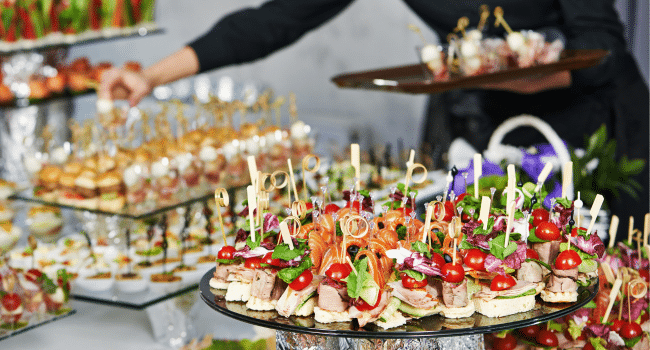Table of Contents
When guests arrive at an event and are greeted with beautifully presented food and flawless service, it’s easy to overlook the incredible amount of preparation and coordination that goes on behind the scenes. From early morning prep to the final plate cleared, event catering is a fast-paced, high-stakes world built on precision, timing, and teamwork.
Here’s a look at what a typical day looks like for an event caterer, and why the right team can make or break the guest experience.
Planning and Prep Work
Long before the event starts, the catering team is already in motion. It usually begins with reviewing the event details, including guest count, dietary restrictions, timeline, and menu. Chefs start prepping ingredients, washing produce, trimming meats, and assembling sauces or garnishes. Organization is critical at this stage. Every tray, utensil, and garnish must be accounted for to avoid delays later.
For a company like 49 Square event catering, this prep process is streamlined with detailed checklists, assigned roles, and a well-coordinated kitchen team. The goal is to get ahead of any surprises while keeping food fresh and presentation on point.
Packing and Transport
Once the food is prepped, it’s carefully packed in labeled containers and loaded into temperature-controlled vehicles. Transporting food for an off-site event is one of the most critical phases. Timing is everything. If even one tray is left behind, it can disrupt the entire service. Teams double and triple-check equipment, ingredients, serving ware, and decor items before heading out.
On-Site Setup
Arriving on-site hours before guests, the catering crew begins setting up the kitchen and staging areas. This might include renting and assembling portable kitchens, setting up buffet lines, or prepping plating stations. Simultaneously, front-of-house staff polish glassware, arrange utensils, and rehearse service timelines.
Communication is essential. Coordinators check in with the event planner or venue manager, confirm timing for speeches or special announcements, and adjust the serving plan accordingly.
Showtime Execution
When guests begin to arrive, everything must be perfect. Servers work in sync to deliver plated meals or pass hors d’oeuvres with grace and professionalism. In the kitchen, chefs are focused on plating each dish with consistency and elegance, often within very tight time windows.
It’s high-pressure, but when done right, it looks effortless. Great event caterers are masters of staying calm, adapting quickly, and problem-solving on the fly.
Breakdown and Cleanup
After the final dessert is served and the last toast made, the cleanup process begins. Tables are cleared, equipment is broken down, and the site is left spotless. Meanwhile, the team is already debriefing—what went well, what can be improved, and what to adjust for tomorrow’s event.
Why It Matters
A smooth, polished event doesn’t happen by accident. Behind the scenes, catering professionals are juggling logistics, presentation, timing, and customer service in a high-speed environment. Their attention to detail and commitment to excellence are what transform a gathering into a memorable experience.
The next time you attend a beautifully catered event, remember the dedicated hands that made it possible, because the best catering feels seamless, even when it’s anything but.
